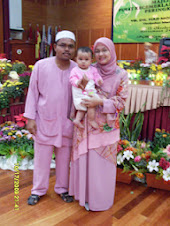Salam...
How about today..hope happy always yea...
I'm fine but still with a lot of works to be settle..
Just to share with us...a kind of a fabric is called as a FLANNEL...
Biasa dengar kan...ada yang dah biasa but for a newbie..maybe it is a new for them...
So today, i will let u know about the Flannel...search a little info from a google and wikipedia...
This is a Flannel Floral Fabric...
Flannel is a soft woven fabric, of various fineness. Flannel was originally made from carded wool or worsted yarn, but is now often made from either wool, cotton, or synthetic fibre.
Flannel may be brushed to create extra softness or remain unbrushed.
The brushing process is a mechanical process where a fine metal brush
rubs the fabric to create fine fibers from the loosely spun yarns.
Typically, flannel has either a single- or double-sided nap.
Double-napped flannel refers to a fabric that has been brushed on both
sides. If the flannel is not napped, it gains its softness through the
loosely spun yarn in its woven form. Flannel is commonly used to make tartan clothing, blankets, bed sheets, and sleepwear.
Flannel Designer Coordinates...
The origin of the word is uncertain, but a Welsh origin has been suggested as fabric similar to flannel can be traced back to Wales, where it was well known as early as the 16th century. The French term flanelle was used in the late 17th century, and the German Flanell was used in the early 18th century.[1]
Flannel has been made since the 17th century, gradually replacing the
older Welsh plains, some of which were finished as "cottons" or friezes, which was the local textile product. In the 19th century, flannel was made particularly in towns such as Newtown, Montgomeryshire,[2] Hay on Wye,[3] and Llanidloes.[4] The expansion of its production is closely associated with the spread of carding
mills, which prepared the wool for spinning, this being the first
aspect of the production of woollen cloth to be mechanised (apart from fulling). The marketing of these Welsh woollen clothes was largely controlled by the Drapers Company of Shrewsbury.[5][6][7]
At one time Welsh, Yorkshire, Lancashire and Irish flannels differed
slightly in character due largely to the grade of raw wool used in the
several localities, some being softer and finer than others. While
nowadays, the colour of flannel is determined by dyes, originally this
was achieved through mixing white, blue, brown and black wools in
varying proportions. Lighter shades were achieved by bleaching with sulphur dioxide.[8]
Flannel Plain Fabric...
The origin of the word is uncertain, but a Welsh origin has been suggested as fabric similar to flannel can be traced back to Wales, where it was well known as early as the 16th century. The French term flanelle was used in the late 17th century, and the German Flanell was used in the early 18th century.[1]
Flannel has been made since the 17th century, gradually replacing the
older Welsh plains, some of which were finished as "cottons" or friezes, which was the local textile product. In the 19th century, flannel was made particularly in towns such as Newtown, Montgomeryshire,[2] Hay on Wye,[3] and Llanidloes.[4] The expansion of its production is closely associated with the spread of carding
mills, which prepared the wool for spinning, this being the first
aspect of the production of woollen cloth to be mechanised (apart from fulling). The marketing of these Welsh woollen clothes was largely controlled by the Drapers Company of Shrewsbury.[5][6][7]
At one time Welsh, Yorkshire, Lancashire and Irish flannels differed
slightly in character due largely to the grade of raw wool used in the
several localities, some being softer and finer than others. While
nowadays, the colour of flannel is determined by dyes, originally this
was achieved through mixing white, blue, brown and black wools in
varying proportions. Lighter shades were achieved by bleaching with sulphur dioxide.[8]
Flannel Plain Fabric...
Flannelette typically refers to a napped cotton the texture of flannel. The weft is generally coarser than the warp.
The flannel-like appearance is created by creating a nap from the weft;
scratching it and raising it up. Flannelette can either have long or
short nap, and can be napped on one or two sides. It comes in many
colours, both solid and patterned.[9]
Cotton flannel or Canton flannel is a cotton fabric napped on one side or two sides.
Ceylon flannel was a name for a wool and cotton mixture.[8]
Flannel, flannelette, and cotton flannel can be woven in either a twill weave or plain weave. The weave is often hidden by napping on one or both sides. After weaving, it is napped once, then bleached, dyed, or otherwise treated, and then napped a second time.[citation needed]
Hope you will understand now about the flannel...you can buy in many store here and also can get online from me or HERE...
Let we continue our work...
Till then..see u
Bubye :-)
(-: H@PpY SeWiNg & Cr@fTiNg :-)
CORETAN BY DSUEFIA COLLECTION





















0 comments:
Post a Comment